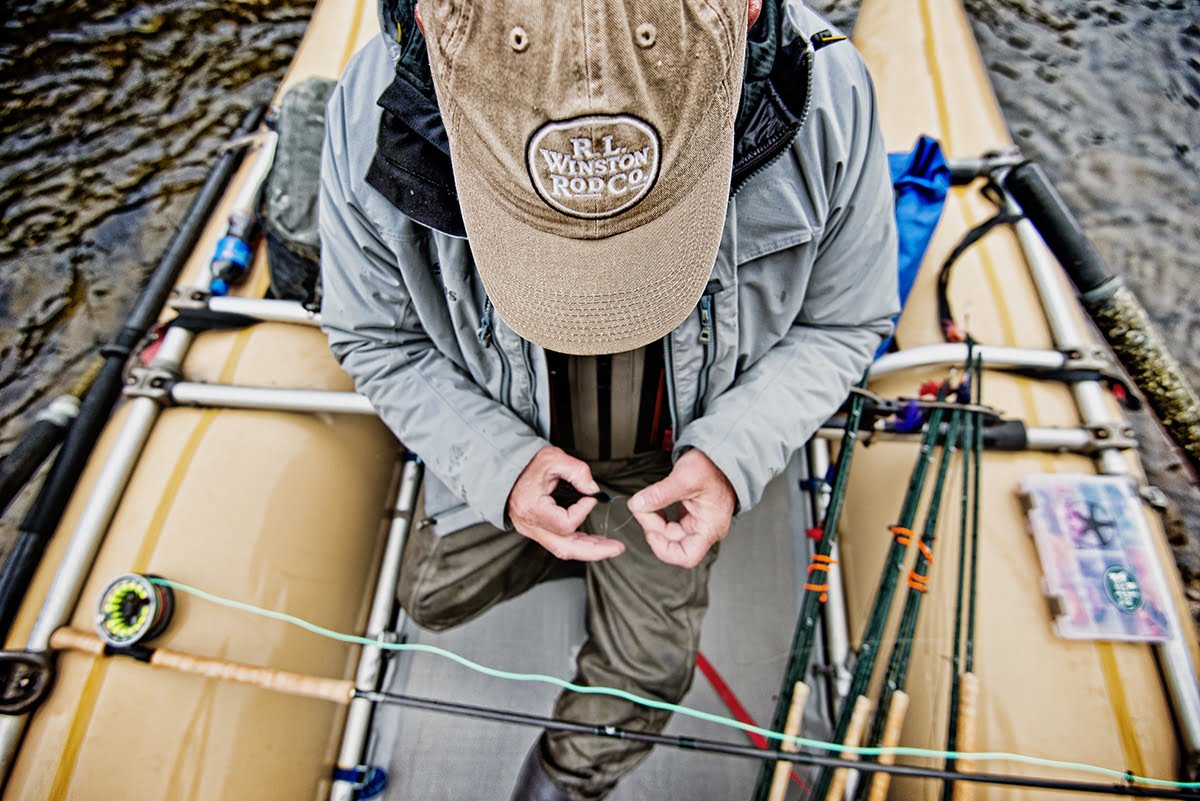
NEVER in my years as a guide, retail manager or instructor, have I ever heard anyone say that they love rigging rods. Let’s face it, rigging and re-rigging rods, isn’t fun. For me, the experience is so much better doing it “right” the first time. I put the most value in choosing the correct flies and rigging multiple rods that will correspond best with the day’s conditions, which allows me to do less rigging for myself or my clients, and much more fishing. So, in a nutshell, I personally do everything I possibly can to avoid re-rigging on the water, even if I do find myself, fruitlessly trying to force 3x through the eye of a #26 midge larva pattern.
For me, a conversation summarizing a successful day on the water might go like this:“How’d it go today?”
Me: “Awesome!”
“So you slayed it huh?”
Me: “No, I got skunked, but I never had to re-rig all day!”
Yes, sadly, sometimes my measure of a successful day on the water is that I didn’t have to re-rig.
Exaggeration aside, fly fishing will always involve re-rigging, but proper rod selection and taking more than one rod with you to the river, is both a time and game saver. This may be yesterday’s news to the seasoned fly fisher, but if you guide and work in the industry long enough, it’s astonishing how often people are surprised that one would have a dry fly rod, a nymphing rod and a streamer rod, pre-rigged at the ready, during a day on the water. Heck, taking all the variables of golf into consideration, people don’t bat an eye bat at a player lugging around twelve clubs. Twelve golf clubs, that’s it? I have more hammers. If I only had twelve fly rods, I might as well throw in the towel and become a yoga instructor.
For me it’s always the same scenario…that one rising fish, just there to taunt you, just there to make you ask yourself if it’s worth cutting off two flies, eradicating split shot (the most difficult single task in all of fly fishing), and removing the indicator, at the risk dropping the screw top of your Air-Lock into the water.
No way, I say! I string up my 6-weight and reach for my 4-weight dry fly set up, complete with 7X tippet and my favorite #24 Trico, and enjoyably spend the next 45 minutes, trying to show the fish who’s boss. The fish either eats or he doesn’t. No harm, no foul. And it’s a heck of a lot more fun fishing tricos on a 4 weight than a 6 weight! Either way, I can quickly go back to my 6 weight and nymph rig; no on second thought needed as my 6-weight is ready to rock and roll. On a side note, just remember that the more gear you take, the easier it is to forget it on the river, but name tags and having Winston inscribe your name on your green stick are always a great back up plan.
Here’s a few things to consider when bringing two or more rods to the river:
1. Size of fish
2. River size, flows, depths, clarity and flora density in and around riparian zones.
3. Required leader and tippet strength and sized based leader shy fish, flows and clarity
4. Wind
5. Practicalities. Are you floating, wading, hiking long distances?
6. Type of fly line being used
7. Insect activity, species diversity, hatches and emergencies. (Yes rod selection can change based on what insects occur where and when!)
I remember reading somewhere that a guy built an entire house just with a Swiss Army knife. While this certainly would be a remarkable feat, it goes to show you that with a few extra tools, the experience might be a bit more enjoyable, and you’d be less crazy at the end.
When it’s all said and done, we can make our 9’ 5 weight “work” for a multitude of fresh water applications. The question is, with the variety of choices in rods available to anglers today that addresses specific types of water, conditions and fish, why not use the best tool for the job? It makes the experience better, with more time spent on the water than sitting on the bank.
If I’ve learned one thing from working on my car, it’s to use the proper tools, just ask my bloody knuckles.
Robert Younghanz, aka The Bug Guy, is an internationally known Fly Fishing Guide, author, instructor and Director of the Colorado Fly Fishing Guide Academy. Check out Robert’s nationally bestselling 2 set DVD: The Bug Guy: Entomology For The Fly Fisher. www.the-bug-guy.com
Here at Winston, we’re happy to help build the perfect multi-rod quiver molded around your personal fishing style. Please give us a call at 406.684.5674 and we’ll find rods that fit your needs. For popular Winston complimentary rod combinations among our customers and pros, see lists below:
TROUT QUIVER:
10’ 3-weight Super 10 (Nymphing)
8’6” 4-weight Air (Small Dry Fly Presentations)
9’ 6-weight Boron III X (Small Streamers, Dry Dropper)
STREAMER QUIVER:
9’ 6-weight Plus: (Trout, Smallmouth, Carp)
8’9” 8-weight Jungle: (Largemouth, Pike)
9’ 10-weight Plus: (Muskie)
STILLWATER QUIVER:
10’ 5-weight Super 10 (Long Leader, Indicators, Float Tubes)
9’6” 6-weight Plus (Sinking Lines, big flies, long casts, heavy wind)
9’ 6-weight Air (dry fly work, damsels, small streamers)
SALTWATER/JUNGLE QUIVER:
9’ 7-weight Plus (Bonefish, Speckled Trout, Ladyfish, Floating Lines)
9’ 9-weight Plus Jungle (Permit, Golden Dorado, Peacock Bass, Baby Tarpon, Redfish, Sinking lines)
9’ 11-weight Plus (Giant Tarpon, Giant Trevally)
SPEY QUIVER:
11’ 4-weight Microspey (Trout, Smallmouth, Streamers, Soft Hackles)
12’6” 6-weight TH (Summer Steelhead, Skaters, Mouse Patterns)
13’6” 8-weight TH (Steelhead, Salmon)



Please forward one of each! I will be happy to write a verification of your recommendations for the rod to use in each situation. lol. I own 7 Winstons and enjoy each one.
My modest Winston quiver:
*Boron III LS 8’6″ 4 weight – small dry fly’s. Absolute dream of a rod with a double taper line. Performs surprisingly well in the Missouri River wind for being so soft.
*Boron II MX 9′ 5 weight – do it all rod from smaller streamers to nymph rigs to presenting dry’s. My wife’s favorite and is usually strung up with an indicator, split shot, and two nymphs with a standard weight forward fly line
*Nexus 9′ 6 weight – great streamer rod. performs better, in my opinion, than most of the other high end rods I have with a different name on them. Strung up with a shooting head, sink tip, and one or two streamers. Also a great hopper/dropper rod.
*(future rod) Kairos 12’3″ 6 weight two hander. Sincerely hoping this “black rod” has a similar taper to the Nexus. Cannot say enough good things about the Nexus for the price. Hoping to have soon!!